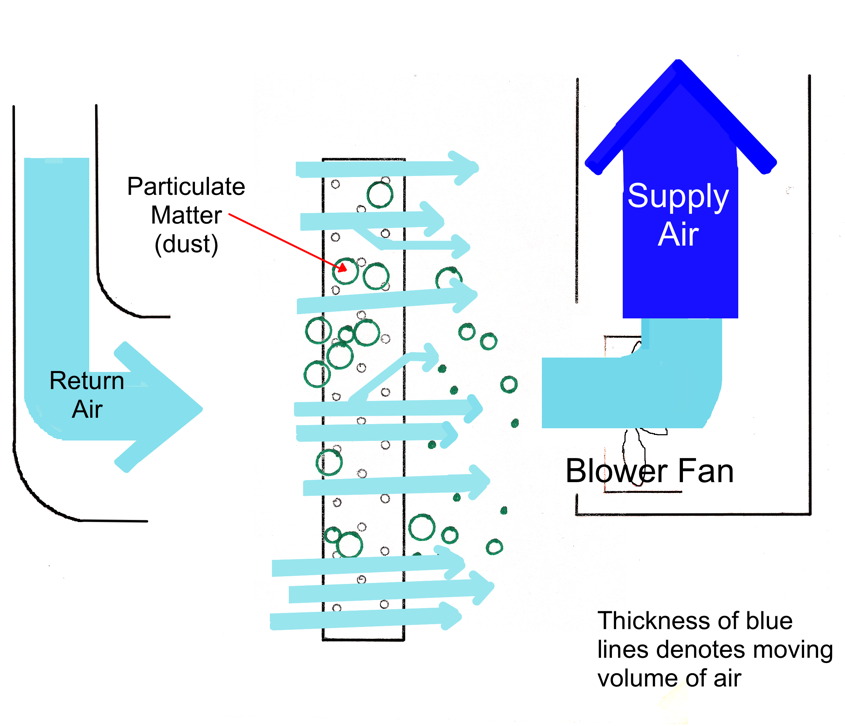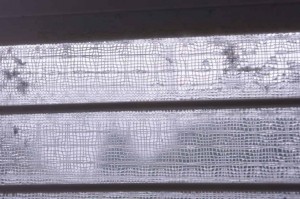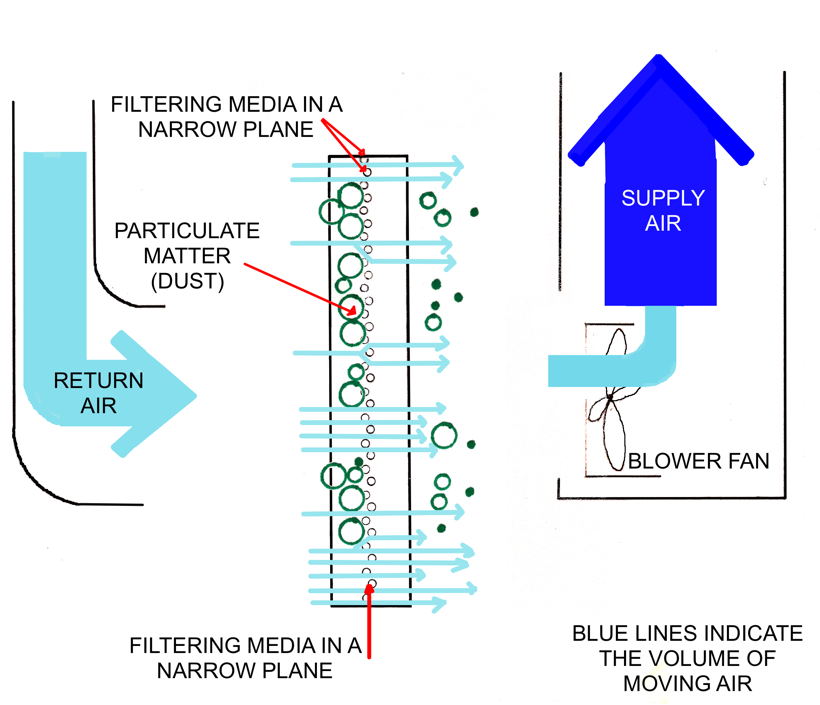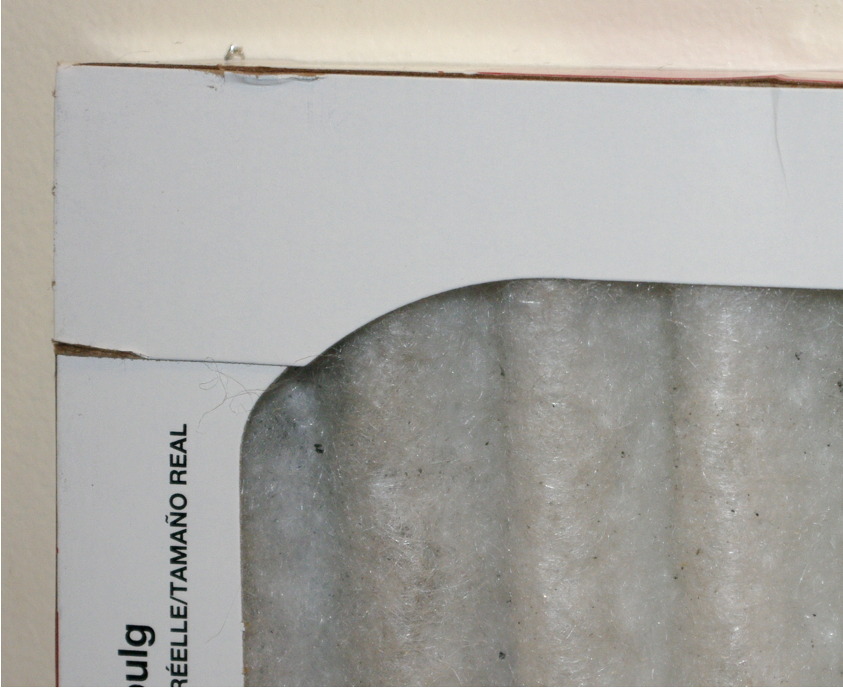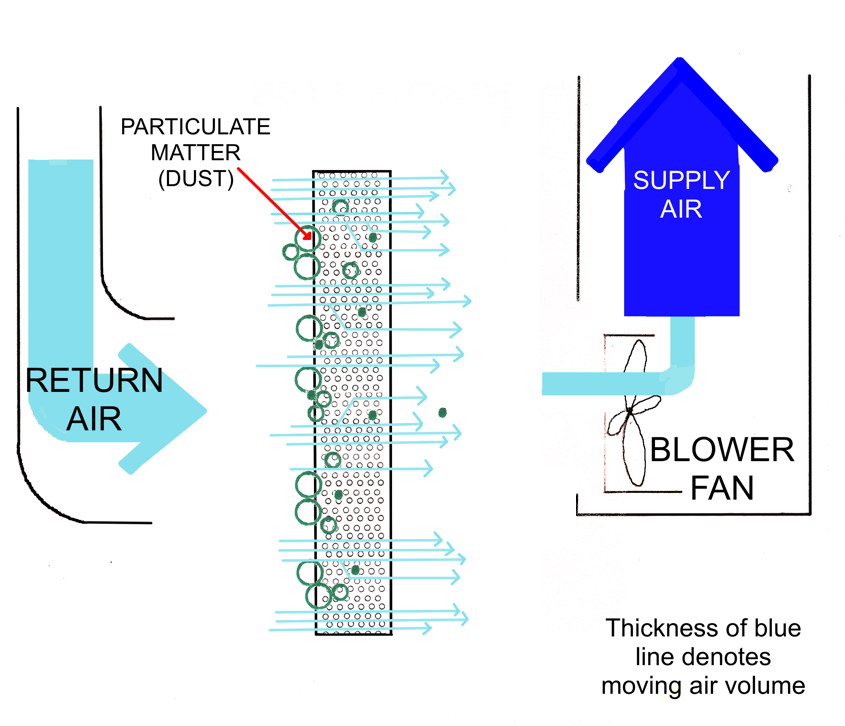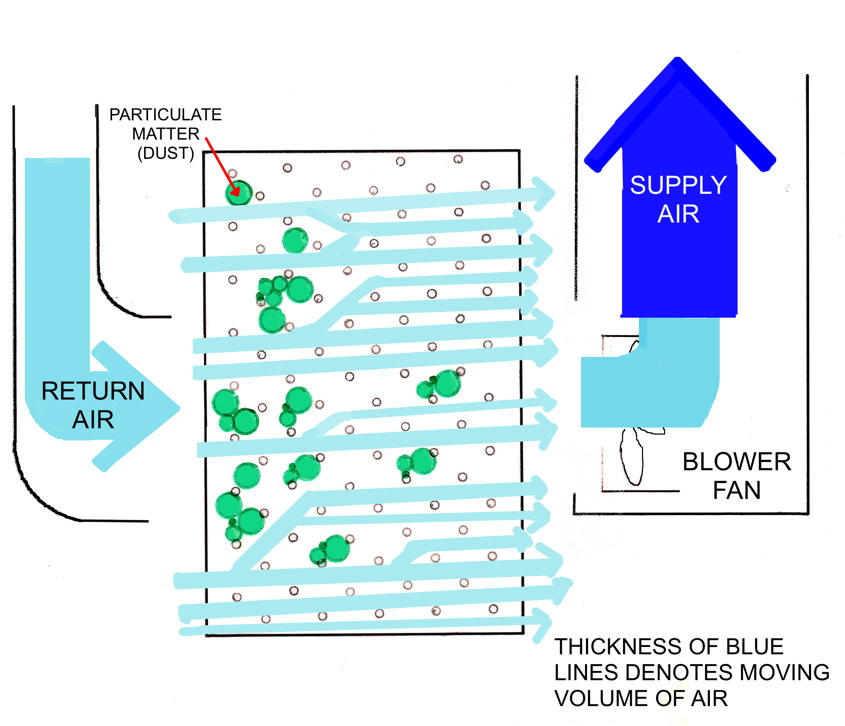Furnace filters compared
Okay, lets look at some examples of what is available in the market today with their advantages and disadvantages.
Fibreglass filters. MERV 1 to 4. $1.25 to $3.00
This category is the least expensive filters you can buy. The filter on the right was purchased at Canadian Tire. All big box stores sell similar filters to the one on the right. I have seen some brands that use blue fibreglass instead of white.  I found that all of these filters are not very dense at all. You can see the couch right through them in the picture above, and they would be on the lower end of the MERV scale. Besides having a lower density, the filter on the right of the picture is missing one key component that should be a deal breaker for any purchase. It is missing the metal cage support on the back side of the filter (see picture on right). All other types of filters have support in one way or another. Basically the purpose of it, is to prevent the filter from being sucked into the fan if it is blowing at high speed. The filter on the left is a “Dafco Aerostar” was purchased at a local HVAC supply store for $2.25 a piece. I could not find the higher density fibreglass with support at any of five of Ontario’s major hardware/building supply box stores. Lets take a look at how this filter performs when installed.
I found that all of these filters are not very dense at all. You can see the couch right through them in the picture above, and they would be on the lower end of the MERV scale. Besides having a lower density, the filter on the right of the picture is missing one key component that should be a deal breaker for any purchase. It is missing the metal cage support on the back side of the filter (see picture on right). All other types of filters have support in one way or another. Basically the purpose of it, is to prevent the filter from being sucked into the fan if it is blowing at high speed. The filter on the left is a “Dafco Aerostar” was purchased at a local HVAC supply store for $2.25 a piece. I could not find the higher density fibreglass with support at any of five of Ontario’s major hardware/building supply box stores. Lets take a look at how this filter performs when installed.
The airflow through these filters is excellent due to having holes that are wide in diamter in comparison to other filters. As you can see from the picture, the low density does not impede airflow that much and does not encourage a static pressure drop. Fibreglass is able to trap only larger particles as it (green circles), but those particles are not only trapped on the front surface layer, but throughout the full 1″ thickness of the filter. Being trapped in different layers encourages good airflow. Some filters are better at filtration than fibreglass, but they are very thin, and get clogged up more easily because it does not use the full 1″ thickness. This good airflow reduces noise during operation.
Verdict: Controversial even between HVAC professionals as they cannot agree if it is the best all around, instead I will focus on its advantages and disadvantages. A good quality fibreglass is the excellent for airflow, and average for your furnace’s long term health, causing little strain to the components, while covering them with slightly more dust. Poor for filtering. Good noise control. Very poor indoor air quality, and poor in the environmentally conscious department due to it being disposable, but not a too intensive manufacturing process.
Washable Filters / Reusable Filters. MERV ~4. $25-$65
Though reusable filters seem at first glance to be the most environmentally friendly filters, they have their caveats and may not be most environmentally conscious product available today for filtering. The picture on the left is a polyester washable filter that is dirty. The picture on the right is the same filter just cleaned. There are still some dirty areas because you can’t be “too rough” when cleaning or the membrane will break. Some areas of the washable filter inevitably become difficult to clean, and this comes with the territory with owning this type of polyester filter, that it’s filtering effectiveness is reduced over time.
One of the biggest problems with it’s filtering ability, is that the thickness of the filter is not really 1″ thick. There is a thin membrane in the centre. This membrane is in a narrow plane. The issue with this type of filter, is that one plane is the only line of defense for filtering, while other products utilize the whole 1″ thickness to capture particles while maintaining airflow. Once the particle makes it past the plane, comes through the other side without a second layer of filtering resulting in poor filtering performance. No other filter has such a thin membrane. It makes sense if you think about it. When you clean a surface, the dirt has to be able to be washed away, and that cant be done if there were multiple layers. It’s like trying to clean the dirt out of a couch or mattress. You can really only clean the surface layer. If you had multiple filter layers, the dirt would get lodged inside, and would not be able to come out. My example at the top, even with only one layer still had some dirt leftover that I could not remove (without breaking it). If it were possible to clean multiple layers, the manufacture would have put in several layers. In the future maybe some manufacturers will invent a method to disassemble a filter with multiple layers in the future so each layer could be individually be cleaned resulting in better MERV ratings and less turbulence, by making the holes slightly bigger. Hey that’s a good idea. Patent pending!. I find it highly doubtful for any washable filter to have a rating above MERV 4. Due to your filters clogging up on only one layer, your standard 3 month replacement schedule may be much shorter.
The other major issue with this filter is with airflow is poor. If you have a filter that uses the whole 1″ thickness, and there is an obstruction caused by dirt, the air has a chance to move around that dirt (like an air passing over and under and airplane wing). But when you only have one surface area with no depth, and it is blocked, the air is forced to move through that restricted dirty area. Your static pressure difference just hit a wall, and now you are making your furnace fan work much harder than it should, burning up more fuel and using more electricity to heat or cool your home at the designed temperature. Another side effect is the air passing through the filter will be very loud as the air tries harder and harder to move through obstructed air. If you have a bedroom or an office next to your furnace room, you will notice the loud “whistling” sound, I guarantee it. In addition a lot of the coatings degrade over time, meaning your filter is not “lifetime”, and this is especially the case if your filter is made of foam rather than polyester. If you have a UV light in your HVAC system, it will degrade your washable filter much faster. Do you still think this is the most environmentally conscious choice?. It is a hard question to answer definitvely without doing energy modelling and a life cycle analysis, but my gut feeling tells me it is one of the worst performers of the lot.
Verdict: There is a consensus between HVAC technicians on this filter. They find them poor performers all around. Very poor for airflow, poor for your furnace’s long term health. Poor at filtering, Very poor in the indoor air quality. Poor noise control (it can get loud while running the A/C on full) Average in in environmentally conscious category due being washable, but increased environmental impacts on reducing system components.
Medium quality cotton, paper or polyester. Merv 6-8. $5 to $8
The filter on the left is a “Garrison” MERV 8 filter from Canadian Tire, and the filter on the right is an “AAF Dust Shield” MERV 6 filter from Lowes. These filters are priced as the middle of the road solution. Both filters are pleated giving a larger surface area than a flat filter like the fibreglass and the washable. The larger surface area can trap more particles and contribute to the filters being louder during use. Lets take a closer look at the performance.
The pleated filters don’t have a wide plane as the fibreglass (they don’t use the whole 1″ thickness), but are thicker than washable filters. They do a much better job at filtering than a MERV 4 filter, and can block some mould spores. There is an improvement in indoor air quality, but MERV 6 – 8 filter still let through allergens along with most other smaller particles. It is not an ideal solution if indoor air quality is at the top of your list. This filter is a little restrictive with airflow, but not too bad.
Verdict: Airflow is average. Filtering quality is average. Indoor air quality is average. Poor noise control due to it’s pleated shape (this is almost unavoidable). Average in in environmentally conscious category due to having one of the best effects for system components on the long term, but of course it is disposable.
Filtrete or other MERV 11 to MERV 12. $15 to $30
Filtrete’s media is very “fluffy” like stuffing in a stuffed animal. In addition to being pleated, it is easy to see how particles can get caught is material that is more “fluffy”, and this filter’s effective thickness is better than the mid range filters, though not the full 1″. Due to these filters very often being electrostatic, the MERV rating is exadurated to a higher number. This is falsehood (which I will explain later), and you should watch out for it. Lets look at a close up of the filter in place.
There is no question that a large amount of particles are blocked by the filtrate filter having smaller holes. There are many small holes that are tightly woven together similar to a high thread count with fabrics, the amount of drag (turbulence), or static pressure drop is even worse than the washable filter. In fact, the affect on airflow is so drastic that HVAC technicians who care know not to recommend these filters inside their customer’s furnaces unless they intentionally oversized the motor. This is common practice only for those who need this extra filtration whose are very sensitive to Indoor Air Quality. If you really want this type of filter, you can sit down with your HVAC technician, he can find out if your furnace was oversized (which happens relatively often). If it is oversized, then you may be in luck. Like the washable filter, this filter will reduce the life of your system components by making the fan work harder to move conditioned air into the spaces you need, and subsequently, it can hinder your furnace or A/C’s ability to heat or cool a room. If you are set on using a filter like this one, spend the money for an HVAC technician service call and ask him to perform the “static pressure drop” test to know if it is possible to use one in your current configuration. This filter will be really loud when installed.
Verdict: Airflow is very poor. Filtering quality is excellent. Excellent. Very poor noise control. Very Poor in in environmentally conscious category due to more material waste and detrimental effects to system components over the long term.
Alternatives: 4″ thick MERV 8 to 12 filters $25 to $40
Most furnaces have a standard 1″ thick slot to fit a filter. It is possible to get better performance from the previous categories by using a 4″ filter, but an HVAC technician has to be able to expand your slot (playing around with sheet metal), which is no easy task, and has to provide a motor that will be able to pull air through a very thick filter. Don’t be surprised if you have to replace your motor with one that can pull air through this. The filtering performance is very similar to a Filtrete 1″ filter.
The one major advantage this setup has over the 1″ high MERV, is that airflow is better. In the above diagram, wherever there is dirt blocking the path of air, the sheer volume of the filter allows the air to take a different path, and its flow is less hindered.
Alternatives: Permanent filter.
I’m not going to say it’s overkill, but I will not go into too much detail about this filter type as other system components need to be modified. This is a very expensive solution. Ask your HVAC tech if it’s for your needs.



